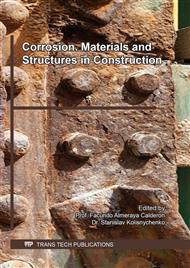p.720
p.725
p.731
p.736
p.741
p.748
p.753
p.760
p.764
Coating Thickness of Reinforced Concrete Affecting to Cathodic Polarization and Cyclic Voltammogram of Reinforced Steel
Abstract:
The reinforced concretes are often exposed to severely corrosive environments such as sea water, contaminated water, acid rain and seashore etc.. Therefore, the reinforced steel bar embedded in the concrete is increasingly corroded in various environments mentioned above, and this corrosion problem is thought to be very important in terms of the safety and economic points of view. In this study, a multiple mortar test specimen(W/C:0.5) with variation of coating thickness was prepared and immerged in flowing seawater for five years. And, the effects of coating thickness affecting to cathodic polarization and cyclic voltammogram were investigated using electrochemical methods. The thinner coating thickness, both invasion and diffusion of dissolved oxygen, water and chloride ion on the surface of reinforced steel bar is more easily compared to the thicker coating thickness. Thus, at the beginning of immersion, the rate of corrosion in the case of the thinner coating thickness is higher than that of the thicker coating thickness. However, it is considered that corrosion products deposited on the surface due to higher corrosion rate played the role as a resistance polarization, and increased the diffusion layer, as a result, decreased the corrosion current density compared to the thicker coating thickness. Consequently, the relationship between corrosion current density and the coating thickness were not well in good agreement with each other due to the corrosion products after being immersed for 5 years. Therefore, in order to more optimum evaluate for corrosion possibility of the reinforced steel embedded in the concrete, not only corrosion potential but also other parameters such as coating thickness, W/C ratio, and other corrosion environment should be investigated in the case of immersed in seawater for long years.
Info:
Periodical:
Pages:
741-747
Citation:
Online since:
December 2016
Authors:
Price:
Сopyright:
© 2017 Trans Tech Publications Ltd. All Rights Reserved
Share:
Citation:



